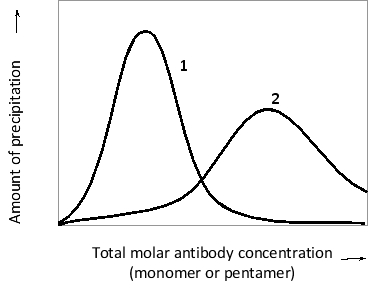Antigens and antibodies can form large, insoluble, cross-linked aggregates that precipitate from solution. The maximal amount of precipitant is observed at a certain antigen/antibody ratio; adding either excess antigen or excess antibody can prevent (or even reverse) the precipitation. Consider an antigen with multiple identical antigenic determinants that can be recognized by either bivalent or decavalent (i.e. pentameric) antibodies with binding sites that recognize the determinants. The amount of precipitation in the presence of a constant antigen concentration is plotted as a function of antibody concentration in the following qualitative graph. Which curve (1 or 2) in the graph do you think corresponds to the bivalent antibody? Would you expect to see such a bell-shaped curve if the antibodies were monovalent? 
A) Curve 1; yes
B) Curve 2; yes
C) Curve 1; no
D) Curve 2; no
E) Curve 2; only if the antigen was also monovalent
Correct Answer:
Verified
Q18: How are natural killer (NK) cells different
Q19: Consider two receptors, one inhibitory and one
Q20: Polyclonal antibodies can be generated against almost
Q21: Indicate whether each of the following statements
Q22: Indicate whether each of the following descriptions
Q24: The transcription regulator AIRE (autoimmune regulator) plays
Q25: In antigen presentation to helper T cells
Q26: Which of the following better describes cross-presentation
Q27: Consider the following three diseases associated with
Q28: After having cereal and nut mix for
Unlock this Answer For Free Now!
View this answer and more for free by performing one of the following actions

Scan the QR code to install the App and get 2 free unlocks

Unlock quizzes for free by uploading documents